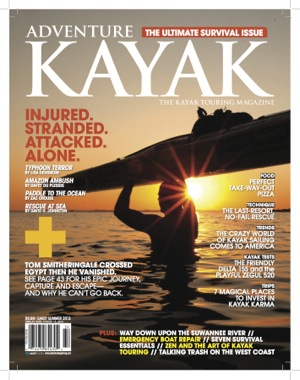Deep in the heart of North America, surrounded by forest and field, there is an ocean.
A vast inland sea containing nearly a quarter of the world’s freshwater—enough to flood the lower 48 states to a depth of almost 10 feet—the Great Lakes contain upwards of 35,000 islands and their 10,000 miles of shore rival that of the U.S. ocean coastlines.
To those who dismiss them as “mere lakes”—mild tempered, serene and dreadfully boring—I invite you to consider the following.
As on the world’s seas, large weather systems can sweep in to whip the water to a violent fury. Storms originating on the hot, dry northern plains rush out over the lakes and unwary paddlers, increasing their ferocity with every mile.
When I visited the Battle Island light, the northernmost Great Lakes lighthouse, in Rossport, Ontario, the keeper there recounted how a 1977 winter storm sent three-story waves rolling past the tower, while spray and chunks of ice broke the glass out. “There’s 250 miles of fetch between here and Duluth,” he said. “So when the waves got here…well, they were pretty big.”
Also like the world’s oceans, the Great Lakes offer a water highway for vessels ranging in size from sea kayaks to thousand-foot-long bulk freighters. Deep in the American heartland, nearly 2,000 miles from the nearest ocean, it isn’t uncommon to see a cargo ship from Sweden sidle up to a dock in Milwaukee to unload wind turbine parts, while another takes on a load of grain bound for Jordan or coal for South Korea.
The same storms that threaten kayakers can plague even these large vessels. The first ship to sail the Great Lakes, La Salle’s Le Griffon, was almost inevitably the first to sink, presumed lost in a Lake Michigan storm while on her maiden voyage in 1679. The lakes account for nearly a quarter of all U.S. shipwrecks—nearly 8,000 in total.
Still have your doubts that these are real seas? Don’t tell that to the U.S. Coast Guard, who is responsible for safety and security on the 6,700 miles of America’s “third coast” bordering the Great Lakes and Saint Lawrence Seaway, performing everything from search-and-rescue operations to annual ice-breaking duties.
There are differences between the Great Lakes and the ocean, of course. But even these show that the lakes can be every bit as mercurial as the sea.
Only Lake Superior boasts any sort of measurable lunar tide (less than two inches), but all the Great Lakes can experience seiches, storm-surge-like oscillations of water caused by wind or atmospheric pressure variations. In 1929, a seiche with 20-foot waves came ashore near Grand Haven, Michigan, and swept 10 beachgoers from the pier. A 1995 seiche on Lake Superior raised and then lowered the water by over three feet, leaving small boats in Duluth’s harbor dangling from their mooring lines.
A ranger in the Apostle Islands National Lakeshore related how three kayak campers were stranded on Outer Island when a mysterious rise in water levels claimed their unsecured boats one night. Savvy Great Lakes paddlers—like their salty brethren—pull their kayaks far above the typical high-water mark and tie them to trees at night.
The very composition of freshwater lends it some distinctly different behaviors from seawater. Lake water is simply less dense: For paddlers, this lighter density creates steeper, sharper waves more easily whipped up by the wind. Rather than the gently rolling swells typical on the ocean, Great Lakes waves tend to stack up into taller, short-period waves with steeper vertical faces and breaking crests.
Lake or ocean? Ultimately, the question is irrelevant. If you have to take sides, you don’t get it. Instead, you’d be wise to humbly accept the Great Lakes on their own terms: a singularly beautiful and utterly unique place we call the Fresh Coast.
Jeffrey Lee edits www.SuperiorPaddling.com, a site that seeks to inform and inspire sea kayakers to explore the endless possibilities of paddling in the upper Great Lakes region.

This article first appeared in Adventure Kayak, Early Summer 2013. Download our free iPad/iPhone/iPod Touch App or Android App or read it on your desktop here.



